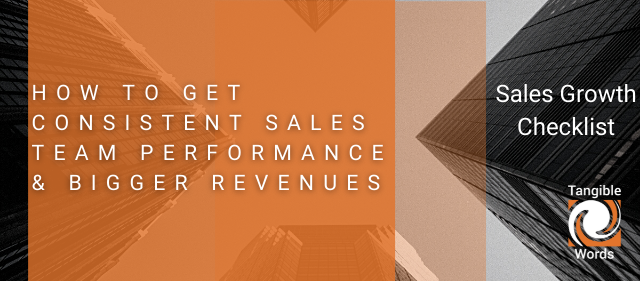SHARE
How to Make Sales Prospecting Enjoyable: HubSpot Prospecting Tools

What makes it difficult for you to hit your prospecting numbers? For me, prospecting does not happen when I don't have a way to make it happen efficiently, and effectively.
Even if you have a:
-
Prospecting work plan (#s you want to hit, and contacts you want to work)
-
Distraction-free zone
-
Colleague, mentor or friend holding you to your goals
-
Computer quickly dialing your list
-
Spotify playlist rocking between calls to get your rocking and working at a high pace
You are not alone if you find it challenging to complete your sales prospecting activities, let alone enjoy it.
Here are some of Tangible Words’ tips for sales prospecting using HubSpot Prospecting tools to create more productive and profitable prospecting.
HubSpot Prospecting Tools Make Productive Prospecting Easier
Using HubSpot Prospecting Tools to manage your sales taskscan ease the stress of your sales role. Try these tools to make your prospecting more enjoyable and profitable:
1) Set up Records Customization for your Sales Team
When you’re ready to make a call, it helps to have the most vital contact information at your fingertips and to see only the details you deem most important to your calls. Such at-a-glance information prompts you to focus on the prospect’s needs and gives you information to help you have more informed discussions. But too much information in the space where you are working can be distracting. Use Records Customization to make only the properties that will help your team be visible. NB: You can customize this for your whole team, or just yourself. You can use Records Customization for Deals, Objects, Companies or Tickets in HubSpot.
2) Filters and Saved Views let you Work “buckets’ of Prospects (on Contact, Company or Deal Records)
Filters help you work contacts or deals that have similar properties in common at once. You can use them on Company, Contact or Deal Records, and once you have the right filters set up, you can “Save a view” in HubSpot to return to it whenever you need. When the view is saved, you can go back to it to see the deals that meet the filter parameters and work on them from there. For example, if you want to see all your contacts at certain Lead Status with “No Associated Deal” you can.
How to set up your Deal Pipeline with Your Favourite Filters
-
Go to Deals, Contacts or Companies.
-
Add all the filters that are important to you for this object (Deals, Contacts or Companies).
-
Hit Save - usually you’ll have to “add a new view” since the default view is a HubSpot made view.
-
Go to All views and pin your view to the top.
3) Align Deal Stages with the Sales Process
You can edit and control your sales process using deal stages. Pair your deal stages with tasks or steps that align with how you’re moving a prospect through their buying journey. Build on the default stages of a deal adding client-focused tasks that help you interact beyond a sales pitch.
Added Required Properties for Each Deal Stage
In your deal pipelines make sure to add custom properties like “Deal Next Steps” and using Sales Pro, you can make certain properties required for a deal to be moved to the next stage. This helps you get a standardized process across your team and how you sell, and of course it also tells you to proceed with each lead and stay on track chasing the money.
4) Don’t Fear The Closed Lost - Embrace it.

Don’t be afraid to open and close deals sooner: in fact embrace this and you’ll be more successful in sales.
Why open a deal sooner: if you spend time researching a client who you think is a good fit and you reach out to them, make a deal so you can “chase the money.” Most reps focus on working the deals in their pipeline so it makes sense to keep them organized by opening the deal sooner.
Finally, if you’ve spent time researching the brand, your effort needs to be logged in some way and creating a deal is a great way to track this. You can set a low probability close rate in this first deal stage if you’re worried about inflated metrics. But every organization wants net new deals being created each week, it is a critical metric for healthy sales growth.
Opening a Deal sooner is good for your company: Information like “good fit” lets anyone who takes over the deal from you have your research earlier. The early back and forth (before a sale is even discussed) of building a relationship and helping for free makes your brand human and your brand healthy. It also makes prospects feel like we’ve already started working together, even though it's still part of the sales process. Saving those dialogues and conversations keep prospects connected to your brand no matter who they eventually buy from, even years later.
Why Closed Lost Is Your Best Spot for Prospecting: Rarely in a considered purchase (which is all B2B sales) do people engage on the first outreach. In sales, it’s never a question of “no,” it’s “not right now.” Your prospect is unlikely to respond to you on your first outreach, but their familiarity with your brand will grow with each helpful touchpoint you offer. Don’t be afraid to move the Deal to Closed Lost sooner so you can work on other deals. Your Closed Lost Deal Stage can become the most fertile ground for prospecting 60-90 days later since they will know you and the timing may have changed.
You can also make a workflow to remind you of Closed Lost Opportunities in HubSpot: You can never know 100% why a deal was lost. Bad timing may be a factor, or your prospect needed to face more challenges to realize they need help. Using workflows, you can have a task auto-generate to reach out at a later date and try again.
5) Make your calls through HubSpot
Using HubSpot to make calls makes you more productive. Here’s why:
-
You can work in one window. When you have all of your call and prospect information in front of you while you’re talking, it’s easier to record the details of the call outcomes. When you keep comprehensive notes of your calls, you can use this information to analyze what went well or what you can work on for next time.
-
Use Snippets in calls from HubSpot. Snippets are carefully scripted words you only need to create once and reuse. Creating a snippet for a prospecting call script of questions lets you drop it in the notes of your call under each answer. So you have your script right in front of you to make sure you touch on all the points you want to make. You can also use snippets in emails! If you’ve written an effective sales letter or email, create a snippet from it. Then you don’t have to keep trying to write it from scratch each time you need the language.
You can find Snippets under Conversations in your HubSpot portal. When you create a new snippet, you can assign it a hashtag. Your hashtag lets you drop the snippet text anywhere you need to access the details.
If you haven’t tried it before, here’s how to make prospecting calls from HubSpot https://knowledge.hubspot.com/calling/use-the-calling-tool.
6) Use Sequences for Each Deal Stage
B2B sales is a tough gig. To manage the psychological hurdles of sales prospecting, you need:
-
a system to follow and track your progress
-
all your activities are organized for you, and
-
content to help you work through the deal with compelling information.
Sales enablement tools help your team plan and follow through with sales tasks with ease. The sequence tool lets you set a salesperson’s activities on a given lead at any stage in the funnel. When you send sequences between deal stages, you can help progress the deal to the next stage without letting the prospect get cold. You can use sequence names to report on deals won and the associated revenue. You can learn how to build custom reports here.
Streamline Your Sales Process to Make Your Monthly Sales Goals
Hopefully the tips above help you remove the pain from your prospecting tasks and boost your sales success.
-
Identify a system that works for how you connect with your prospects.
-
Be prepared by using HubSpot tools to help organize and make your tasks easier.
-
Follow up with reporting to see what works and what doesn’t. Tweak and repeat.
Enroll in our HubSpot Boot Camp and We’ll Help You Design Your Systems:
Topics
- Content Creation (297)
- Growth-Driven Design Websites (167)
- Inbound Marketing (145)
- Sales Growth (133)
- Tangible Words (111)
- Search Engine Optimization (85)
- Social Media Marketing (83)
- Hubspot (76)
- Blogging for Business (75)
- Economic Development (64)
- Events & Training (60)
- Company Growth Podcast (49)
- Manufacturing (47)
- Tourism (46)
- Email Marketing (42)
- Case Stories (40)
- Testimonials & Client Feedback (36)
- Education and SaaS (23)
- Google (21)
- Careers (19)
- Inbound Marketing Agency (19)
- Cool Companies (18)
- FAQ (16)
- Alysha Dominico (13)
- Associations (7)
- Food and Beverage (7)
TW Blog Sign-Up
Learn more about how to grow your business and improve your sales team process.







